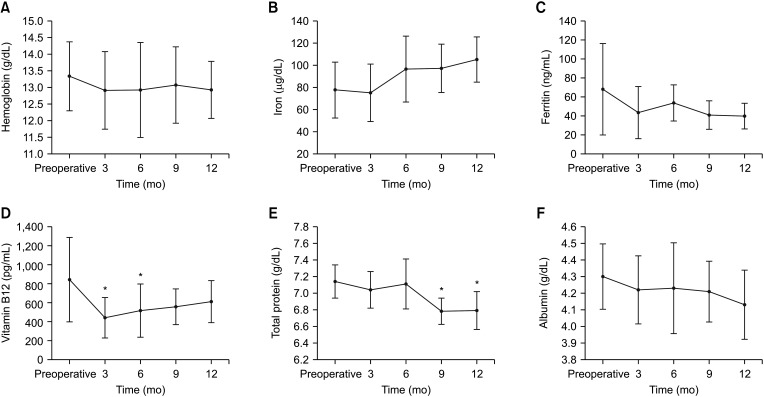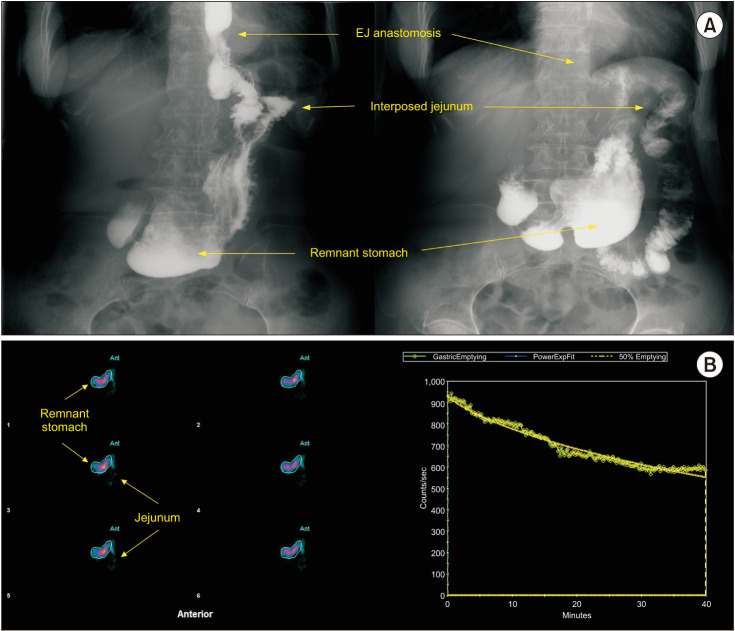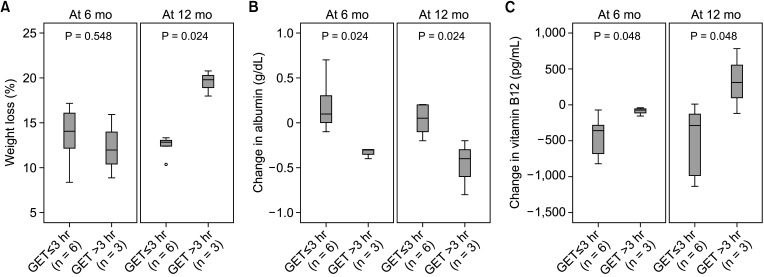Ann Surg Treat Res.
2024 Jun;106(6):313-321. 10.4174/astr.2024.106.6.313.
Food passage following proximal gastrectomy with double-tract reconstruction and its effect on nutritional status in early gastric cancer: a prospective single-center cohort study
- Affiliations
-
- 1Department of Surgery, School of Medicine, Kyungpook National University, Daegu, Korea
- 2Department of Surgery, Kyungpook National University Chilgok Hospital, Daegu, Korea
- 3Department of Surgery, Kyungpook National University Hospital, Daegu, Korea
- 4Department of Nuclear Medicine, School of Medicine, Kyungpook National University, Daegu, Korea
- KMID: 2556322
- DOI: http://doi.org/10.4174/astr.2024.106.6.313
Abstract
- Purpose
Laparoscopic proximal gastrectomy with double-tract reconstruction (LPG-DTR) expectedly results in improved nutritional status and less body weight loss than conventional total gastrectomy in upper-third gastric cancer. This study aimed to investigate the food passage patterns following LPG-DTR and its effect on nutritional outcomes up to 1 year after surgery.
Methods
This prospective cohort study recruited 10 patients with early gastric cancer scheduled for LPG-DTR. Nutritional indices and body composition were assessed every 3 months up to 12 months. Liquid and solid food transits were evaluated with fluoroscopic upper gastrointestinal study and radionuclide scintigraphy, respectively.
Results
At 12 months, patients exhibited a body weight loss of 14.5% ± 3.6%. The main passage routes for liquid and solid foods differed, primarily via the interposed jejunum for liquids, whereas via both tracts for solids. The median half-life of solid food emptying from the remnant distal stomach was 105.1 minutes (range, 50.8–2,194.2 minutes), and duodenal passage of solid food was noted in 9 of 10 patients. Those with gastric half-emptying time >3 hours demonstrated greater weight loss (19.5% ± 1.4% vs. 12.5% ± 1.1%, P = 0.024) and more pronounced reduction in serum albumin levels (–0.5 ± 0.3 g/dL vs. 0.0 ± 0.2 g/dL, P = 0.024) after 12 months.
Conclusion
LPG-DTR demonstrated varying food passage patterns depending on the food contents and delayed solid food emptying from the remnant stomach was associated with more substantial weight loss.
Figure
Reference
-
1. Information Committee of the Korean Gastric Cancer Association. Korean Gastric Cancer Association-led nationwide survey on surgically treated gastric cancers in 2019. J Gastric Cancer. 2021; 21:221–235. PMID: 34691807.2. Khalayleh H, Kim YW, Yoon HM, Ryu KW, Kook MC. Evaluation of lymph node metastasis among adults with gastric adenocarcinoma managed with total gastrectomy. JAMA Netw Open. 2021; 4:e2035810. PMID: 33566106.3. Yura M, Yoshikawa T, Otsuki S, Yamagata Y, Morita S, Katai H, et al. Oncological safety of proximal gastrectomy for T2/T3 proximal gastric cancer. Gastric Cancer. 2019; 22:1029–1035. PMID: 30778799.4. Haruta S, Shinohara H, Hosogi H, Ohkura Y, Kobayashi N, Mizuno A, et al. Proximal gastrectomy with exclusion of no. 3b lesser curvature lymph node dissection could be indicated for patients with advanced upper-third gastric cancer. Gastric Cancer. 2017; 20:528–535. PMID: 27379895.5. Nozaki I, Hato S, Kobatake T, Ohta K, Kubo Y, Kurita A. Long-term outcome after proximal gastrectomy with jejunal interposition for gastric cancer compared with total gastrectomy. World J Surg. 2013; 37:558–564. PMID: 23254949.6. Yoo CH, Sohn BH, Han WK, Pae WK. Long-term results of proximal and total gastrectomy for adenocarcinoma of the upper third of the stomach. Cancer Res Treat. 2004; 36:50–55. PMID: 20396565.7. An JY, Youn HG, Choi MG, Noh JH, Sohn TS, Kim S. The difficult choice between total and proximal gastrectomy in proximal early gastric cancer. Am J Surg. 2008; 196:587–591. PMID: 18519129.8. Aikou T, Natsugoe S, Shimazu H, Nishi M. Antrum preserving double tract method for reconstruction following proximal gastrectomy. Jpn J Surg. 1988; 18:114–115. PMID: 3386066.9. Zhao Q, Li Y, Guo W, Zhang Z, Ma Z, Jiao Z. Clinical application of modified double tracks anastomosis in proximal gastrectomy. Am Surg. 2011; 77:1593–1599. PMID: 22273215.10. Kim DJ, Kim W. Laparoscopy-assisted proximal gastrectomy with double tract anastomosis is beneficial for vitamin B12 and iron absorption. Anticancer Res. 2016; 36:4753–4758. PMID: 27630323.11. Jung DH, Lee Y, Kim DW, Park YS, Ahn SH, Park DJ, et al. Laparoscopic proximal gastrectomy with double tract reconstruction is superior to laparoscopic total gastrectomy for proximal early gastric cancer. Surg Endosc. 2017; 31:3961–3969. PMID: 28342130.12. Park JY, Park KB, Kwon OK, Yu W. Comparison of laparoscopic proximal gastrectomy with double-tract reconstruction and laparoscopic total gastrectomy in terms of nutritional status or quality of life in early gastric cancer patients. Eur J Surg Oncol. 2018; 44:1963–1970. PMID: 30197164.13. Cho M, Son T, Kim HI, Noh SH, Choi S, Seo WJ, et al. Similar hematologic and nutritional outcomes after proximal gastrectomy with double-tract reconstruction in comparison to total gastrectomy for early upper gastric cancer. Surg Endosc. 2019; 33:1757–1768. PMID: 30203207.14. Lee I, Oh Y, Park SH, Kwon Y, Park S. Postoperative nutritional outcomes and quality of life-related complications of proximal versus total gastrectomy for upper-third early gastric cancer: a meta-analysis. Sci Rep. 2020; 10:21460. PMID: 33293604.15. Kimura K, Ebihara Y, Tanaka K, Nakanishi Y, Asano T, Noji T, et al. Initial results of laparoscopic proximal gastrectomy with double-tract reconstruction using oblique jejunogastrostomy method on the long-term outcome of postoperative nutritional status: a propensity score-matched study. Surg Laparosc Endosc Percutan Tech. 2021; 31:603–607. PMID: 34049369.16. Lee SS, Chung HY, Kwon OK, Yu W. Long-term quality of life after distal subtotal and total gastrectomy: symptom- and behavior-oriented consequences. Ann Surg. 2016; 263:738–744. PMID: 26501699.17. Lee JH, Hyung WJ, Kim HI, Kim YM, Son T, Okumura N, et al. Method of reconstruction governs iron metabolism after gastrectomy for patients with gastric cancer. Ann Surg. 2013; 258:964–969. PMID: 23324857.18. Yasuda A, Yasuda T, Imamoto H, Kato H, Nishiki K, Iwama M, et al. A newly modified esophagogastrostomy with a reliable angle of His by placing a gastric tube in the lower mediastinum in laparoscopy-assisted proximal gastrectomy. Gastric Cancer. 2015; 18:850–858. PMID: 25318978.19. Ahn SH, Lee JH, Park DJ, Kim HH. Comparative study of clinical outcomes between laparoscopy-assisted proximal gastrectomy (LAPG) and laparoscopy-assisted total gastrectomy (LATG) for proximal gastric cancer. Gastric Cancer. 2013; 16:282–289. PMID: 22821182.20. Tokunaga M, Ohyama S, Hiki N, Hoshino E, Nunobe S, Fukunaga T, et al. Endoscopic evaluation of reflux esophagitis after proximal gastrectomy: comparison between esophagogastric anastomosis and jejunal interposition. World J Surg. 2008; 32:1473–1477. PMID: 18264827.21. Ahn SH, Jung DH, Son SY, Lee CM, Park DJ, Kim HH. Laparoscopic double-tract proximal gastrectomy for proximal early gastric cancer. Gastric Cancer. 2014; 17:562–570. PMID: 24052482.22. Park DJ, Han SU, Hyung WJ, Hwang SH, Hur H, Yang HK, et al. Effect of laparoscopic proximal gastrectomy with double-tract reconstruction vs total gastrectomy on hemoglobin level and vitamin B12 supplementation in upper-third early gastric cancer: a randomized clinical trial. JAMA Netw Open. 2023; 6:e2256004. PMID: 36790808.23. Davis JL, Selby LV, Chou JF, Schattner M, Ilson DH, Capanu M, et al. Patterns and predictors of weight loss after gastrectomy for cancer. Ann Surg Oncol. 2016; 23:1639–1645. PMID: 26732274.24. Yamashita K, Iwatsuki M, Koga Y, Toihata T, Kiyozumi Y, Kuroda D, et al. Preservation of physiological passage through the remnant stomach prevents postoperative malnutrition after proximal gastrectomy with double tract reconstruction. Surg Today. 2019; 49:748–754. PMID: 30929080.25. Vasavid P, Chaiwatanarat T, Pusuwan P, Sritara C, Roysri K, Namwongprom S, et al. Normal solid gastric emptying values measured by scintigraphy using asian-style meal:a multicenter study in healthy volunteers. J Neurogastroenterol Motil. 2014; 20:371–378. PMID: 24948129.26. Nakajima K, Kawano M, Kinami S, Fujimura T, Miwa K, Tonami N. Dual-radionuclide simultaneous gastric emptying and bile transit study after gastric surgery with double-tract reconstruction. Ann Nucl Med. 2005; 19:185–191. PMID: 15981670.27. Abell TL, Camilleri M, Donohoe K, Hasler WL, Lin HC, Maurer AH, et al. Consensus recommendations for gastric emptying scintigraphy: a joint report of the American Neurogastroenterology and Motility Society and the Society of Nuclear Medicine. Am J Gastroenterol. 2008; 103:753–763. PMID: 18028513.28. Hayashi T, Kinami S, Fushida S, Fujimura T, Miwa K, Inoue K. Evaluation of residual stomach motility after proximal gastrectomy for gastric cancer by electrogastrography. Dig Dis Sci. 2006; 51:268–273. PMID: 16534668.29. Iwata Y, Ito S, Misawa K, Ito Y, Komori K, Abe T, et al. Incidence and treatment of metachronous gastric cancer after proximal gastrectomy. Surg Today. 2018; 48:552–557. PMID: 29460126.
- Full Text Links
- Actions
-
Cited
- CITED
-
- Close
- Share
- Similar articles
-
- Single-Port Laparoscopic Proximal Gastrectomy with Double Tract Reconstruction for Early Gastric Cancer: Report of a Case
- Proximal Gastrectomy with Double Tract Reconstruction Using the Remnant Antrum in Early Upper Gastric Cancer
- Laparoscopic Proximal Gastrectomy as a Surgical Treatment for Upper Third Early Gastric Cancer
- Updated Review of Proximal Gastrectomy for Gastric Cancer or Cancer of the Gastroesophageal Junction
- Comparison of Reconstruction Methods after Distal Gastrectomy for Gastric Carcinoma in Terms of the Long Term Physiologic Function and Nutritional Status; Billroth I Gastroduodenostomy versus Roux-en Y Gastrojejunostomy





